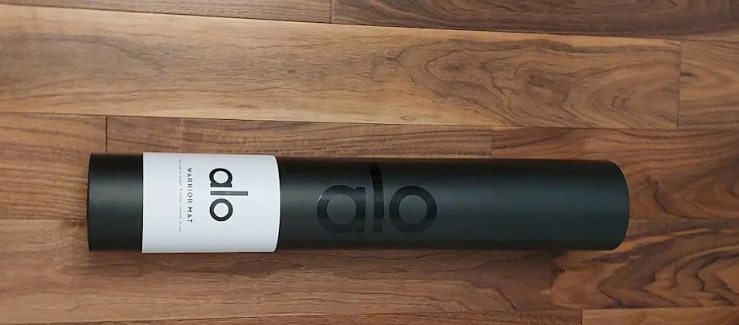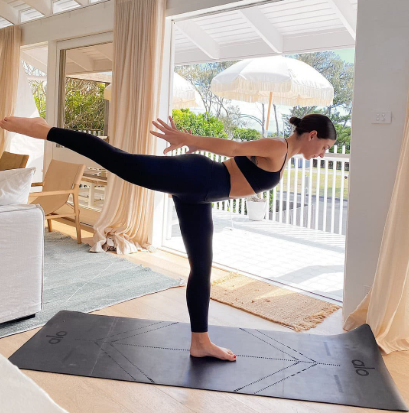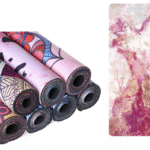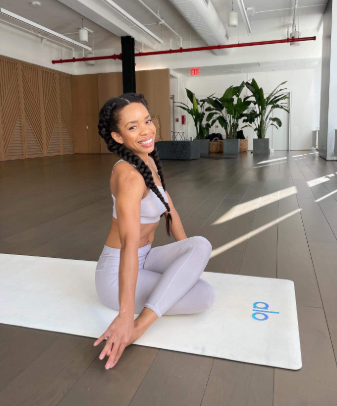Alo Yoga has become one of the most talked-about names in the yoga world. You’ve seen their custom yoga mats all over Instagram. Influencers and wellness enthusiasts carry them everywhere. But here’s the real question: is all that buzz justified? Or are you just paying for the brand name?
I get it. Spending over $100 on a yoga mat feels like a big commitment. You want to know if it’s going to elevate your practice. Or is it just another overhyped product riding the wave of social media marketing?
Here’s what this review will cover:
-
Real performance testing across different yoga styles
-
How Alo’s materials hold up over time
-
Whether the grip, cushioning, and durability justify the premium price
-
Honest comparisons with competitors in the same price range
-
Who should (and shouldn’t) invest in this mat
I’m not here to follow trends. I want to figure out if the Alo Yoga mat delivers genuine value for your practice and your wallet. By the end of this review, you’ll have a clear answer: overhyped marketing gimmick or awesome investment?

Alo Yoga Mat Quick Specs
|
Feature |
Details |
|---|---|
|
Material |
PU + Natural Rubber |
|
Thickness |
5 mm |
|
Weight |
~3 kg |
|
Grip |
Excellent (Dry & Wet) |
|
Comfort |
Firm and stable |
|
Price |
$100–$120 |
|
Pros |
Great grip, stylish, premium feel |
|
Cons |
Heavy, expensive |
|
Rating |
⭐⭐⭐⭐☆ (4.5/5) |
Design & Material
Premium Polyurethane Surface Layer
The top layer features high-grade polyurethane (PU). This isn’t your standard PVC material found in budget mats. Alo chose PU for its better grip and gentle feel on skin.
What this means for your practice:
Absorbs moisture as you sweat instead of becoming slippery
Soft, almost suede-like texture against your palms and feet
No harsh chemical smell when you unroll it fresh from the box
Wipes clean without damaging the surface
The PU surface has a subtle texture. It’s smooth enough to feel comfortable during restorative poses. It also provides enough friction for stability in tough balances.

Natural Rubber Base Layer
Flip the mat over and you’ll find 100% natural rubber. This base layer handles stability and cushioning.
Key performance benefits:
-
Great floor grip – the mat stays put even on polished studio floors
-
Natural germ-fighting properties that resist bacteria and odor
-
Sustainable material sourced from rubber trees
-
Dense enough to protect your joints without feeling squishy
Fair warning: If you have a latex allergy, the natural rubber base won’t work for you. Alo doesn’t offer a latex-free option in their premium line.
Color, Pattern & Aesthetic Design
Alo Yoga mats look gorgeous. I have to say that upfront.
They offer muted, sophisticated color palettes: dusty rose, sage green, navy blue, charcoal grey. No loud neon colors or distracting patterns. The brand logo appears as a subtle emboss rather than a loud statement.
The aesthetic appeal matters because:
-
You’ll use equipment you find beautiful more often
-
It photographs well (yes, that influences purchase decisions)
-
The minimal design doesn’t distract during meditation
But here’s the truth: you’re paying extra for this aesthetic. A less attractive mat could work just as well.
Grip & Comfort
Dry Grip Performance
Right out of the box, the polyurethane surface provides solid initial traction.
I tested basic poses like Downward Dog and Plank during the first few practices. My hands stayed put. No sliding forward. The subtle texture grabs your skin. It doesn’t feel rough or abrasive.
What I noticed in dry conditions:
Stable hand placement during Sun Salutations
Feet don’t shift during Warrior sequences
Smooth transitions between poses without sticking
No need to readjust hand or foot positions
The grip felt reliable but not aggressive. Some mats grab so hard they make transitions awkward. Alo found a sweet spot here.

Wet Grip Performance (The Real Test)
Here’s where things get interesting. This is where most mats fail.
I put this mat through hot yoga sessions, intense vinyasa flows, and sweaty power yoga classes. The kind where you’re dripping within 10 minutes.
Performance when sweat kicks in:
-
The PU surface improves grip as it gets wet
-
Moisture absorbs into the material instead of pooling on top
-
Hands stay locked in Chaturanga even when palms are soaking
-
Feet stay stable during sweaty standing sequences
But there’s a learning curve. The first time the mat gets wet, it feels slippery for about 30 seconds. Then the PU activates and grip kicks in. You need to break it in through 2-3 sweaty sessions before it performs at its best.
After the break-in period? Exceptional wet grip. I compared it against my old Manduka PRO. The Alo handled moisture better. Way better than standard PVC mats that turn into slip-n-slides.
Comfort During Long Holds
I tested this mat during 90-minute yin yoga sessions. These sessions require you to hold poses for 3-5 minutes.
Comfort factors that stood out:
-
The suede-like texture never felt irritating against skin
-
Enough padding to prevent numbness in seated positions
-
Forearms stayed comfortable during long Sphinx pose holds
-
Hips didn’t ache during long Pigeon hold (common complaint on firm mats)
No pressure points developed. No pins-and-needles from circulation getting cut off. The density distributes body weight well.

Related Reading: How To Clean Vegan Suede Yoga Mat
Durability & Care
Long-Term Durability Testing
I’ve used this mat for six months – 4 to 5 sessions per week. I did hot yoga, vinyasa flow, and restorative practice. Here’s my honest wear report.
What held up well:
No peeling or flaking on the PU surface
Edges stayed intact with zero fraying
No separation between the polyurethane and rubber layers
Natural rubber base kept its grip strength
No air bubbles or warping developed
Signs of wear that appeared:
Light compression marks where hands and feet land often
Small dents in high-contact zones (won’t affect how it works)
Minor scuff marks from toenails during transitions
Watermarks if you don’t dry it well after practice
The build quality is solid. After six months of steady use, this mat looks 85-90% as good as new. Compare that to cheaper mats that show serious wear within 2-3 months.

Cleaning Instructions (The Right Way)
How you clean matters. Do it wrong and you’ll damage the PU surface or reduce grip. Here’s what I found works.
After each sweaty practice:
-
Wipe down with a damp cloth right away
-
Use plain water or mix 1:4 ratio of white vinegar to water
-
Don’t soak the mat – just clean the surface
-
Hang or lay flat to air dry all the way before rolling
Deep cleaning (once a month):
-
Fill bathtub or large basin with cool water
-
Add a few drops of mild, pH-neutral soap
-
Lay mat flat and scrub with soft cloth
-
Rinse well with clean water
-
Hang over shower rod or drying rack
-
Allow 24-48 hours for full drying
What NOT to do:
-
Never use harsh chemicals or bleach
-
Avoid hot water (damages PU surface)
-
Don’t put in washing machine or dryer
-
Skip rough brushes or scrubbing pads
-
Never leave rolled up while damp
I made the mistake of rolling mine up damp once. Got a musty smell that took two deep cleans to get rid of. Don’t repeat my error.
Price & Value
Cost Breakdown: What You’re Paying
|
Brand |
Material |
Grip (Dry/Wet) |
Thickness |
Weight |
Price Range |
Overall Rating |
|---|---|---|---|---|---|---|
|
Alo Yoga |
PU + Rubber |
⭐⭐⭐⭐☆ / ⭐⭐⭐⭐⭐ |
5 mm |
~3 kg |
$100–$120 |
⭐⭐⭐⭐☆ |
|
Liforme |
Natural Rubber |
⭐⭐⭐⭐⭐ / ⭐⭐⭐⭐⭐ |
4.2 mm |
~2.5 kg |
$140–$160 |
⭐⭐⭐⭐⭐ |
|
Manduka PRO |
PVC |
⭐⭐⭐⭐ / ⭐⭐☆☆☆ |
6 mm |
~3.4 kg |
$120 |
⭐⭐⭐⭐ |
|
Lululemon Reversible Mat |
PU + Rubber |
⭐⭐⭐⭐ / ⭐⭐⭐⭐☆ |
5 mm |
~2.8 kg |
$98 |
⭐⭐⭐⭐ |
|
Gaiam Premium |
PVC |
⭐⭐⭐ / ⭐⭐☆☆☆ |
6 mm |
~2 kg |
$30–$50 |
⭐⭐⭐ |
Let’s cut straight to the numbers. An Alo Yoga mat costs $88 to $128 depending on which thickness you choose.
Here’s the price structure:
-
4mm standard thickness: $88-$98
-
5mm deluxe thickness: $118-$128
That’s not cheap. This sits in premium yoga mat territory. You’re paying the same or more than established high-end yoga brands.
Price Comparison With Competitor Mats
How does Alo stack up against other premium options? I compared mats in the same quality tier.
Direct competitors:
-
Manduka PRO: $120-$130
-
Lululemon Reversible Mat: $78-$88
-
Jade Harmony: $80-$100
-
Liforme Original: $140-$160
Budget to mid-range alternatives:
-
Gaiam Premium: $30-$40
-
Manduka X: $50-$70
-
Yoga Design Lab: $65-$75
Alo prices higher than Lululemon but lower than Liforme. It matches Manduka’s premium tier.

Cost Per Use Analysis
The upfront price looks steep. But break it down by use and the math changes.
Daily practitioner (5-7 times per week):
– 3-year lifespan = about 780-1,095 sessions
– Cost per session: $0.08-$0.16
Regular practitioner (3-4 times per week):
– 4-year lifespan = about 624-832 sessions
– Cost per session: $0.11-$0.21
Occasional practitioner (1-2 times per week):
– 5-year lifespan = about 260-520 sessions
– Cost per session: $0.17-$0.49
Compare this to buying a $30 budget mat every 6-12 months. You’d spend $90-$180 over three years and generate more waste.
Hidden Costs To Consider
The mat price isn’t your main expense. Factor in these costs:
You’ll need:
-
Yoga towel for hot yoga: $30-$60 (optional but I recommend it)
-
Carrying strap: Included (no extra cost)
-
Cleaning supplies: $10-$15 per year
Total first-year cost:
– Mat: $88-$128
– Towel (optional): $30-$60
– Cleaning supplies: $10-$15
– Total: $98-$203
Each year after:
– Cleaning supplies: $10-$15
– Replacement towel (every 2-3 years): $10-$20 annual average
The hidden costs stay low. You don’t need expensive special cleaners. Basic maintenance keeps ownership cheap.
Pros & Cons
|
Pros 👍 |
Cons 👎 |
|---|---|
|
Excellent grip even during sweaty sessions |
Heavier than most mats |
|
Sleek and stylish premium design |
Higher price range ($100+) |
|
Dense and stable for balance poses |
Can show wear or marks over time |
|
Durable PU + rubber material |
Limited eco-friendly options |
|
Easy to clean and maintain |
Slight rubber smell when new |
Summary
After six months of testing across hot yoga, vinyasa flow, and restorative practices, I can give you a clear answer: the Alo Yoga mat is awesome for specific practitioners, but overhyped for others.
This isn’t a simple yes or no. The verdict depends on your practice style, frequency, and priorities.
Final Opinion: Overhyped or Awesome?
It’s awesome if you match this profile:
You practice hot yoga or sweat a lot during sessions. The wet grip performance sets this mat apart from almost everything else in the market. I tested it against Manduka PRO, Lululemon Reversible, and Jade Harmony. Nothing handled moisture better. Your hands lock in place during sweaty Chaturangas. Your feet stay stable through drenched standing sequences. This feature delivers real value.
You practice 4+ times per week. At this frequency, the cost per use drops to $0.10-$0.20 per session over 3-4 years. The premium price becomes justified through regular use. The durability means you buy once and practice for years without replacement.
It’s overhyped if this describes you:
You practice once or twice a week. At this frequency, you’re paying $0.49 per session over five years. Budget mats at $30-$40 make more financial sense. The premium features don’t get tested enough to justify the investment.
You don’t sweat much during practice. Gentle yoga, restorative sessions, or meditation-focused practice won’t push the mat’s wet grip capabilities. You’re paying for features you won’t use. Mid-range options deliver everything you need for 50-60% less money.
You’re still exploring whether yoga fits your lifestyle. I don’t recommend that beginners invest $88-$128 before knowing their preferred style and commitment level. Start with a $30-$50 mat. Upgrade once you know yoga is part of your routine.

